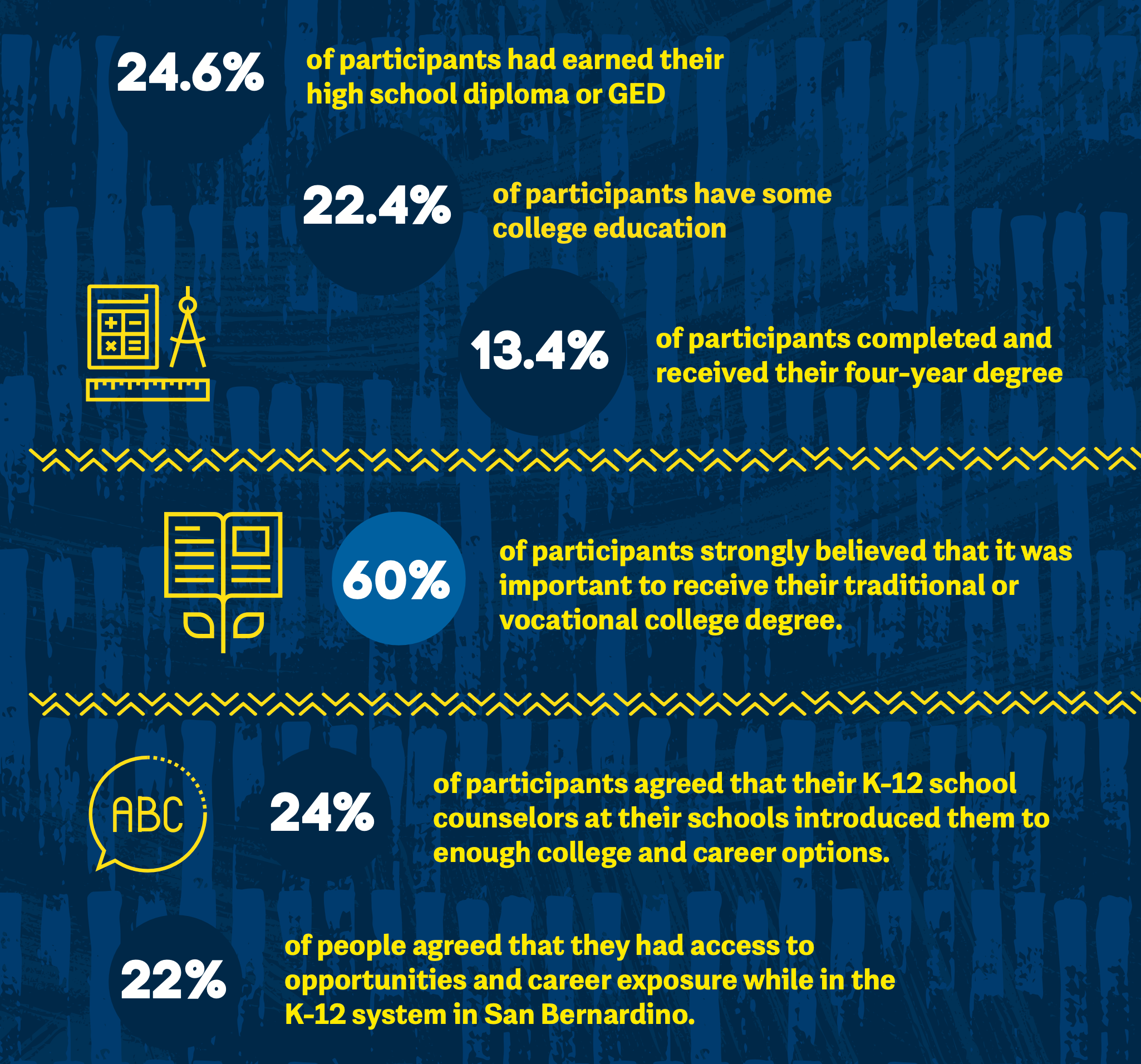Education as a Foundation for Economic Mobility
Education is a central component of a comprehensive economic growth and development strategy. The efficiency of the San Bernardino Unified school district has long been in question by the community. Interestingly, it is not the low high school graduation rates in San Bernardino unified that residents have questioned. Instead, the community has questioned the lack of social preparedness that students exhibit once they have graduated. This lack of preparedness has translated into low levels of college readiness, less than adequate educational services and limited career options exposure for students, all of which have negatively affected the economy of our beloved city. We intend to make systemic changes in our local educational system that will perpetuate the social and economic success of our community as a whole.
What’s the value of education in San Bernardino?
Among those residents surveyed for this project, 24.6% of participants had earned their high school diploma or GED, while 22.4% have some college education and only 13.4% had completed and received their four-year degree. These numbers show a shocking trend in the community that highlights the continuous decline in academic success and validates the community’s concern of the school district’s efficiency. These results raise important questions about the connection between the high school diplomas awarded to our students and their readiness to pursue a higher education.
Our survey data also shows a strong disconnect between the value of college degrees and the number of community members in San Bernardino who have actually attained one. Our survey revealed that while less than fifteen percent of community members finished their college degree, an alarming 60% of participants strongly believed that it was important to receive their traditional or vocational college degree. To add to this, only 24% of participants agreed that their K-12 school counselors at their schools introduced them to enough college and career options. Even more alarming is that a mere 22% of people agreed that they had access to opportunities and career exposure while in the K-12 system in San Bernardino. These data points validate the need for the continuation of the systemic and direct services work that we do in the community in an effort to increase college readiness levels and career access and exposure.
In addition to our survey, we also held community focus groups which allowed us to look deeper at community members’ educational experiences and their feelings about education. These focus groups shed even more light on the work that we must do to improve our K-12 educational system here in San Bernardino. The two most reoccurring themes brought up by the community regarding their k-12 education infrastructure were:
-
- the need for more resources and general guidance at the k-12 level. These resources included general funding, specialized programs and proactive academic counselors.
- the lack of information about higher education alternatives such as trade schools or other vocational training.
Both of these concerns beg the question, how can we implement more support, funds and information that can be directly inserted into the K-12 school system in San Bernardino Unified?
Click to zoom
Solutions to Reach Educational Needs
Our recommendations are based on BLU’s Purposeful Pathways strategy.
BLU Educational Foundation has been directly serving the community of San Bernardino since 2001. The foundation’s work has been dedicated to responding to the higher education challenges faced by community members with limited resources and opportunities in the city. Each year the organization provides students with college academic advising, scholarships, and trains community members with the leadership skills to advocate for our community’s education needs. BLU’s work has also affected systemic change, as they were at the forefront of efforts to pass AB 132, which made it a requirement for students to complete their FAFSA before graduating high school. The FAFSA is an application for government supported financial aid that is awarded to help low-income students pay for tuition, school fees and other school related expenses. BLU has also been heavily advocating for Black students to be specifically named in the district’s Learning Continuity and Attendance Plan (LCAP). Success in this area would ensure that state funds be directly allocated to support Black students in the K-12 system.
As part of the foundation’s work tending to the community’s educational needs, the BLU foundation has spearheaded a timely initiative – Purposeful Pathways. This initiative is centered on providing students with guidance and exposure to impactful careers in growing industries. This early exposure will increase students’ access to mentorship, internships, hands-on experience, informed purposeful course work, and careers that could greatly change the landscape of our communities.
BLU’s purposeful Pathways are:
Health
Education
Business & Finance
Arts, Media & Entertainment
STEM
Environmentalism
Social Justice & Philanthropy
